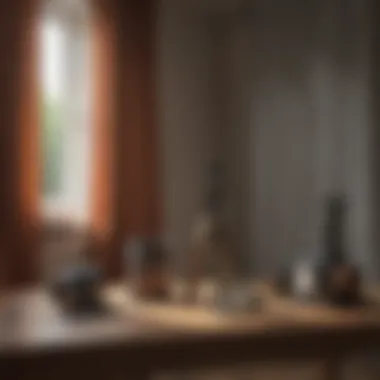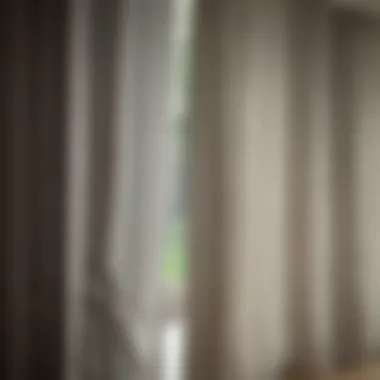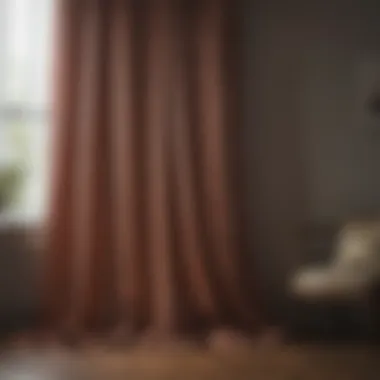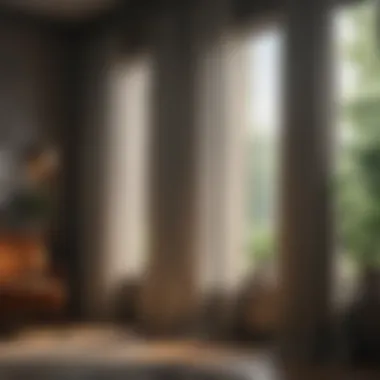How to Measure for Curtains: A Complete Guide


Intro
Taking measurements for curtains is not just a practical task; it is a step that can significantly influence the overall aesthetics of a room. The proper fit of curtains enhances both the functionality and style of windows. Often, homeowners overlook this crucial stage, leading to ill-fitting curtains, wasted fabric, and unnecessary frustration. In this guide, we present the essential techniques and considerations for obtaining accurate measurements, ensuring that your window treatments meet your specific needs and preferences.
We will explore various methods for measuring, discuss the significance of elements such as the type of rod or track, and offer guidance on selecting appropriate curtain styles and materials. Through this information, you will acquire both the confidence and insight to make informed decisions about your curtain choices, vastly improving your living space.
Interior Design Tips
Curtains serve not only as functional window coverings but also as a key element of interior design. They can tie a room together, adding color and texture while providing necessary privacy and light control.
Trendy Design Ideas
Selecting a curtain style that aligns with current trends can provide a refreshing update to your home. Here are some popular options:
- Floor-to-ceiling: This look adds drama and height to a room.
- Sheer fabrics: These allow natural light to filter through while maintaining privacy.
- Geometric patterns: Contemporary designs in fabrics lend a modern touch.
Integrating these styles allows you to create an engaging visual appeal.
Color Schemes and Combinations
The color of your curtains can either complement or contrast your existing decor. Therefore, it's important to choose wisely. Consider using the following combinations:
- Neutral tones: These offer versatility and blend well with many backgrounds.
- Bold colors: Select colors that evoke mood and incorporate them into your palette.
- Two-tone patterns: Multi-colored curtains can create interest and can match various existing elements in your space.
Deciding colors meticulously can amplify the overall theme and design of your room while encapsulating personal style.
Furniture Arrangement Techniques
Furniture layout can affect how curtains appear in relation to the other design elements in your room. Positioning furniture strategically ensures the curtains hang freely without obstruction. Make sure to plan ahead:
- Visually assess window placement alongside sofas or chairs to prevent barrier issues.
- Leave space for an unobstructed curtain operation. - Utilize decorative rugs to separate spaces and guide color choices for curtains.
Thoughtful arrangement contributes to fluid aesthetics and spatial balance within your home.
Accurate measurements dictate the final look of your curtains, influencing both use and design.
In aligning your curtain measurement with effective design, you make room for personal expression while addressing practical necessity, enhancing overall satisfaction with your interiors.
Prolusion to Curtain Measurements
When considering the aesthetic and functional aspects of interior design, curtain measurements are pivotal. Proper measurement ensures that window treatments fit perfectly, enhancing the overall decor of a room. An accurately measured curtain not only fits the windows well but also influences how much light enters, as well as the level of privacy and insulation provided.
Importance of Accurate Measurements
Accurate measurements can often be the difference between elegant drapery and a mismatched setup that detracts from the interior appeal. Curtains that are too short may leave parts of the wall exposed, which makes the room feel incomplete. Conversely, curtains that are excessively long can create cluttered looks and may pose practical issues when drawn open. Thus, ensuring precision in measurement is a critical step.
Moreover, precise curtain sizing allows homeowners to maximize their investment in fabric by reducing waste. This attention to detail also avoids the inconvenience of needing alterations or reorders. Here are some benefits of accurate measurements:
- Aesthetic Harmony: Guarantees visual balance in interiors.
- Practical Efficiency: Ensures curtains function well on rods or tracks, minimizing complications in usage.
- Resourcefulness: Allows owners to make the most of their budget by preventing fabric overuse.
Common Misconceptions About Curtain Sizing
There are prevalent misconceptions surrounding curtain measurements. One common belief is that curtains should always be measured at the width of the window frame. However, considering the desired looks—such as puddling or crumpling—different approaches are necessary.
Another myth is that clearance from the floor is negligible; on the contrary, the gap can significantly affect both style and practicality. Additionally, many people think that any curtain style will suit all rooms. Each window and decor combination may require tailored measurements that correspond well with specific styles. Addressing these misconceptions is essential for achieving desired aesthetics and functionality with curtain designs.


"Effective curtain measurements enhance both the look and function of your space, allowing you to turn an ordinary window into a design focal point."
Ultimately, understanding the facts and acknowledging the misconceptions these facts present is critical to executing the ideal measurement process confidently.
Types of Curtains and Their Measurements
Understanding the various types of curtains and their specific measurements is crucial for any homeowner or interior design enthusiast. Selecting the correct type of curtain can dramatically influence both aesthetics and functionality in a space. It is not merely about preference; different curtain styles serve distinct purposes and require different approachess.
Obtaining the right measurements for these different types your curtains ensures they will fit snugly and operate smoothly within your window space.
Rod Pocket Curtains
Rod pocket curtains are designed with a sewn pocket along the top which allows the curtain rod to slip through. This creates a gathered effect that can add charm to a room. When measuring for rod pocket curtains, width measurement is vital. You prepare it by measuring the exact width of the window. You typically want to aim for a width that is 1.5 to 3 times wider than your window for desired fullness. Care must be taken to also account for element such as finials, brackets, or how high you want your curtains to hang above the window.
Tab Top Curtains
Tab top curtains provide a custom-like look and offer a casual style to a space. The measure for tab top curtains requires both panel width and space for the tabs. Tabs are fabric loops, often sewn at the top of the curtains, through which the rod slides. Similar to rod pocket designs, ensure that the width is adequately sized. If each tab is 4 inches long and there are, for example, eight tabs for two panels, then consider adding 8 inches to the listed width measurement.
This ensures that the tab tops will not impede movement up and down the rod when opening or closing the curtain.
Grommet Curtains
Grommet curtains utilize reinforced holes along the top of curtains for the rod to go through. This style often has a modern appeal and creates clean lines. Precision is critical when measuring grommet curtains. Just like with the other styles, you should measure the width of your window accurately—usually the width of the rod should extend several inches beyond the window frame. An essential detail to remember is the height at which the curtain will hang; the grommets may affect how long the curtain looks when hung. Ensure to measure from the top of the grommet to the preferred end point, whether that's the floor, window sill, or any decorative length.
Using the right techniques, measurements, and styles can enhance a space effectively, balancing aesthetics and function.
By understanding these different types of curtains and how their measurements differ, you empower yourself to make informed design choices affecting overall space feeling and function.
Tools Required for Measuring Curtains
Proper measuring tools are essential for achieving accurate curtain measurements. The right tools ensure the patterns align correctly and contribute to the overall aesthetic of your space. Taking precise measurements prevents costly mistakes. Having basic tools on hand allows for a smooth and efficient measuring process.
Measuring Tape
A measuring tape is the most crucial tool for measuring curtains. It enables homeowners to obtain both the width and length of their windows accurately. When selecting a measuring tape, opt for one that is at least 25 feet long. This length is sufficient for measuring most standard windows without any strain. Moreover, a flexible and retractable measuring tape provides ease of use, especially in tight spaces.
Always ensure the tape is straight and fitted snugly along the edges of the window frame for an accurate reading. Using a metal or fabric tape may also influence the ease of marking specific lengths.
Level and Pencil
A level and a pencil serve together for ensuring that curtain rods hang evenly. When you install curtains, the aesthetic impression relies heavily on their alignment. Using a level guarantees that you are hanging the curtain rod in a perfectly horizontal position.
Having a clear visible mark for the rod's placement simplifies this task. A good quality level, preferably a digital one, helps detect even the slightest discrepancies. A simple pencil makes marking heights and widths straightforward, preventing the hassle that comes with guessing during installation.
Notepad for Recording Measurements
A notepad becomes invaluable for recording measurements, notes, and observations. Accurate deductions from previously taken measurements can sometimes save time. Writing measurements prevents confusion later on, especially for those that need multiple values due to different curtain styles or types.
Designers and homeowners alike should keep this in mind. Carry the notepad around when you measure various types of curtain fabrics later. This habit adds a level of professionalism. In addition, having all results noted ensures a systematic approach to curtain fitting.
"A structured recording of measurements can significantly reduce the margin for error when planning curtain installations."
Step-by-Step Guide to Measuring Windows
Accurate measurements form the backbone of effective window treatment planning. Without precise data, curtains will not fit as intended. Thus, it becomes essential to follow a clear, systematic approach when taking measurements for your curtains. This ensures that you achieve an aesthetic that enhances your space while keeping functionality in mind. This section will dive deeper into the specifics of measuring width and length, clarifying critical strategies related to each.
Measuring Width – Inside the Frame
To achieve a tailored look, start by measuring the width of the window frame from the inside edges. Use a sturdy measuring tape to make this task easier.


- Position the measuring tape to touch the left edge without encroaching upon the frame's interior.
- Extend the tape to reach the right-hand edge of the frame.
- Note the width you obtain, and always round down to ensure the end curtains will not crowd against the frame.
Special attention is necessary because even a slight miscalculation can result in patterns misaligning or curtains under-delivering their intent. Here, it’s wise to concurrently note alternative widths too. Measure again if there are notable differences from existing data.
Measuring Width – Outside the Frame
When measuring for curtains that will hang outside the window frame, dimensions change. This method offers an expanded appearance for your windows and is highly effective for creating a dramatic effect.
- Begin at the point where you'd like the curtain to extend outside the frame. This could be the base of your wall, or even beyond, depending on personal preference.
- Again, laying the measuring tape down to the left; stretch it width-wise until the point you project the curtain to.
- Write down this measurement, and repeat this on the right side of the window frame, ensuring that both sides are even.
Comparing interior and exterior measurements builds a solid foundation. A visual check against furniture or architectural elements helps confirm visual coherence with other design aspects.
Measuring Length – From Rod to Floor
The process to measure the length from the curtain rod to the floor is more straightforward but equally significant. The height allows wearing specific patterns like puddling. Here’s how you can do it:
- Establish where the curtain rod will hang or is already mounted, to begin your measurement.
- Position the tape from this rod location directly downward towards the floor.
- Check to ensure the tape does not curl or bend, which can provide an inaccurate length. Drop it down to where you want the curtains to potentially sit—be it grazing lightly above the floor, pooling upon it, or just at the windowsill level.
Many miscalculations stem from insufficient attention while measuring downward. Maintaining a straight trail from reference points will mitigate unnecessary errors.
Remember: Always consider what type of curtain design you’re opting for, as this influences method execution. Curtains impose both practical and aesthetic contributions to your room, warranting focus during this measurement process.
Calculating Curtain Fabric Requirements
Calculating the correct fabric requirements for your curtains is essential. This section highlights the significance of determining the amount of fabric needed to ensure that your curtains are both functional and aesthetically appealing. Accurate calculations can prevent frustrating delays, excessive costs, and unsuitable designs. Neglecting this step could lead to an imbalanced appearance or curtains of insufficient material, impacting their performance.
Determining Fullness and Panels
When selecting fabric for curtains, it is crucial to consider fullness. Fullness refers to how gathered or pleated your curtains will look. A common standard is to double the width of your window when choosing fabric width. This means that if your window measures 100 inches wide, you’d require around 200 inches of fabric width. Factors affecting this choice include the curtains style—sheer panels may require less fullness, while blackout styles often benefit from a denser fabric appearance.
Keep in mind how many panels you will use: a single panel may suffice for a smaller window but may make larger spaces feel sparse. Gulf-style or layered systems might prompt the need for more than just the basic two panels. In addition, if you aim for a more luxurious look, consider opting for a fullness ratio of 2.5 to 3 times the width of the window for dramatic drapes. Here are key points to consider:
- Style of the curtain: Fullness may differ based on whether you choose a simple sheer versus an opulent blackout.
- Window size: Larger windows benefit from excess fabric, enhancing the fullness approach.
- Personal taste: Consider how much gather appeals to you visually.
Accounting for Hem and Header
Accounting for hem and header requirements is equally necessary. Hems are typically needed at the bottom of curtains to create a polished appearance, preventing fraying while also guiding how your fabric will hang. On average, a hem may add three to five inches to your total fabric requirement. For headers, which attach the curtain to the rod, the necessary fabric depth will also depend largely on the style you're opting for. A tab top style may only need a smaller header, but grommet headers often require additional fabric to accommodate the rings.
Determining these additions works as follows:
- Measure each header type according to your chosen style. The rod pocket approach will involve measuring the total requirement plus the rod's diameter.
- Include a bottom hem measurement traditionally ranging from 3 inches to 6 inches. Adjust based on the design.
- Always factor in sewing allowances where minimal or none might contribute to a mismatch in fit.
This holistic approach will ensure the curtain requirements suit the parameters and preferences of your space well. When you prioritize the details in your fabric calculations, results often lead to successful installations. Direct inquiries to local suppliers or check resources like Wikipedia for detailed fabric sizing tips and guidelines in joining sewing approaches.
Inadequate preparation or misunderstanding of measurements could lead to regrettable outcomes, wasting time and resources while producing unsatisfactory results.
Choosing the Right Curtain Style
Selecting the right curtain style is vital for not just aesthetics but functionality within a space. Your choice affects light control, privacy, and the overall impression of a room. Matching curtain styles to specific window types can transform an ordinary room into something that feels well thought out and coherent. To make informed choices, it's essential to evaluate several factors. Choosing quality materials and suitable designs will serve you not only during installation but for years to come.
Considerations for Room and Window Type
The room and window type significantly influence your curtain selection. Each room has a unique function, which directly relates to the kind of curtains that will work best. For example:
- Living Room: Consider lighter fabrics that allow for ample natural light during the day while maintaining some level of privacy in the evening. Remember options like sheer curtains or light-filtering fabrics.
- Bedroom: Prioritize heavy fabrics, like blackout curtains, which can block out light entirely. This produces a conducive environment for sleep.
- Kitchen: Opt for materials that can withstand humidity, such as cotton or linen footed with curtains that can easy washed. Also, consider styles that can facilitate more accessible access to window sills.


When dealing with irregularly shaped or positioned windows, such as bay windows or skylights, customizable curtains can aid in achieving a seamless look. Therefore, measurements must be precise.
Functional vs.
Decorative Curtains
Curtains serve a dual role—as functional items that dictate light flow and privacy, and as decorative elements that enhance the room’s style. Thus, the functionality must be balanced with style. Go through factors such as:
- Light Control: Functional curtains will adjust how much light a room lets in. If your primary requirement is darkness, select heavier materials or layered curtains.
- Insulation: Heavier materials can act as insulators, reducing heat loss or gain, which is crucial in temperate climates.
- Décor Matching: Always consider how the curtain fabrics and patterns align with the overall theme of your furniture and wall colors. Striking a harmonious balance amplifies aesthetics while retaining functionality.
Choosing between functional and decorative curtains need not be an either/or situation. Many curtains span both categories—like a stylish woven pattern that still serves strategic purposes. It often comes down to what best suits your unique situation.
Lastly, always assess the long-term sustainability and care demands for the chosen material, as it relates to maintaining a suitable environment within each respective room.
Common Pitfalls in Measuring for Curtains
Measuring for curtains seems like a simple task, but several common pitfalls can undermine the whole process. Addressing these challenges is crucial to ensure that your curtains fit not just physically, but that they complement the look of your space too. This section explores pitfalls that you should be aware of when measuring for curtains, which can help avoid wasted materials, time, and money.
Overlooking Obstructions
When measuring for curtains, it is important to take into account any obstructions that can interfere with the proper functioning and aesthetic of your curtains. These may include items such as light fixtures, window handles, air vents, or nearby furniture. Failing to consider these factors can lead to significant issues once the curtains are hung.
For example, if your window is positioned immediately next to a thick wall, ignoring this might result in curtains that cannot be opened without jamming against the wall. Similarly, if your curtain rods are too high or too low due to a light fixture hanging close by, it may disrupt the folding or movement of the curtains themselves. Apaying close attention to obstacles during the measuring process not only saves you from design faux pas, but also enhances the actual functionality and comfort of the living space.
Here are some consideration for avoiding obstructions:
- Identify if there are light switches, blinds, or radiators that could affect placement.
- Consider the space near the window for any nearby furniture.
- Use a clear measuring scheme to identify obstacles when measuring lever.
Key Point: Ensuring an unobstructed curtain opening significantly improves usability and maintains the integrity of your design. If you can see where the hangs will be stuck, you can plan better around obstacles.
Neglecting to Measure Twice
The adage “measure twice, cut once” holds true in the context of curtain measurements as well. It's critical to be cautious and diligent during measurements to avoid any regrets at the time of installation. It might feel redundant, but taking a second measurement often reveals inconsistencies, even with attenteventriditoy duplicates.
First, it’s easy to make simple errors. Removing the measuring tape before confirming the origins of your measurements is a common mistake many make. Also, measuring from high above may render imprecise results, due to the curvature of a tape measure. It may not settle straight, which will slightly alter the readings. Taking both initial and repeat measures potentially catches these typological issues before taking the plunge to purchase curtains, thus maintaining accuracy and cost-effectiveness.
To ensure precise measurements:
- Use the same starting point on the wall every time.
- Choose a trustworthy tape measure, ideally a cloth one to prevent measurement loss with feeling.
- Spend some time reviewing the first and second measurements for clarity.
The responsibility rests with you to follow through and repeat measurements before cutting fabric. Doing so prevents unnecessary returns or reordering of curtains that don’t fit or mix well with the ambiance.
Taking these common pitfalls seriously and executing suggestive remedies creates a far more comforting and visually harmonious use of curtains throughout the home.
Final Thoughts on Curtain Measurements
Curtain measurements may seem trivial at first glance, but they hold significant weight in a room's overall aesthetic and functionality. Taking the time to measure accurately offers numerous benefits, ensuring your window treatments serve both form and function. This final section wraps up the critical points discussed throughout the article. Readers will find valuable takeaways that enhance their understanding of what precise measurements truly mean.
Importance of Precision
Precision in measuring for curtains is non-negotiable. Often, a slight miscalculation can lead to curtains that either overwhelm a space or fall short of providing the desired coverage. Curtains that fit perfectly enhance the spatial dynamics. Not to mention, the various types and styles available, including rod pocket and grommet curtains, require specific measurements for optimal performance. Below are a few core reasons outlining the importance of precision:
- Functional cohesion: Perfect measurements ensure that your curtains function as intended. Drapery that obstructs movement or fails to block light properly can be frustrating.
- Visual appeal: The right fit gives a polished look to the space. Well-measured curtains can elevate a room's style, balancing proportions and symmetry.
- Cost efficiency: Investing in measurements can save you from expenses related to purchasing the wrong size, leading to mistakes and alterations.
In essence, a meticulous approach to measurements assures both aesthetic excellence and practical functionality, serving the homeowner's desires.
Consulting Professionals
While taking measurements can be straightforward for some, there are benefits to enlisting professional help. Interior designers and home décor specialists possess the experience and expertise required for more complex solutions. Consulting such professionals can bridge any gaps in understanding or capability. The following points highlight why seeking expert advice might be advantageous:
- Insights on different curtain styles: A professional can recommend styles that work best with your windows and room configuration, which might not be obvious to an untrained eye.
- Decision support: Choosing fabrics and colors suitable for a particular setting can be assisted by someone knowledgeable. This ensures cohesion in design.
- Precision checks: Professionals confirm measurements and detect any potential issues that might need addressing during installation.
Ultimately, successful home styling, particularly with curtains, is a mixture of accurate measurements, educated decisions, and sometimes, expert support. By understanding these dynamics, homeowners, interior design enthusiasts, and others involved in home decoration can create spaces that reflect their personalities while adding elegance and functionality.







